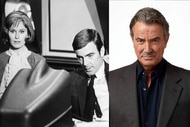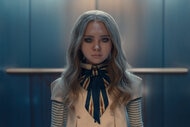Create a free profile to get unlimited access to exclusive videos, sweepstakes, and more!
A short history of digital influencers, from Instagram to Making the Cut

Over the last decade, high fashion has become more accessible to mass audiences. Sure, the price tag still demands a level of exclusivity, but livestreams of runway shows ensure you no longer need a ticket to see the latest collections as soon as they are unveiled. In 2010, Alexander McQueen was the first designer to livestream a Fashion Week presentation, and it has since become part of the norm. Social media has expanded the level of interactive content, which also gives the appearance of closing the gap between creatives and their audience, while a whole new roster of models and designers thrive in its landscape.
Influencers dominate the market, collaborating with big brands in a bid to gain new fans and customers. The route to fame has diversified (to a degree) as the old world meets the new. Now fashion students can immediately share their high-concept work and those blurring the line between fantasy and reality can showcase the out-of-this-world looks. Design competitions, such as the long-running Project Runway, have turned to science fiction and technology for challenge themes, which have long since been a source of inspiration for designers.
Joining the ranks is the new Heidi Klum and Tim Gunn Amazon series Making the Cut, which is splashing Bezos cash all over its high production value. This includes flashy runway shows in Paris and Tokyo, with the latter providing the technologically enhanced backdrop in the recent episode "Opposing Forces." The ultra-modern presentation is an "immersive digital fashion showcase" asking the designers to consider the notion of style dichotomy with a guest appearance from one of the biggest virtual influencers in the audience.
Since 2016, a new kind of digital influencer has entered the fray, taking the concepts of Photoshop and distorted reality up a notch. As the fashion industry explores its options in the current social distancing climate, self-proclaimed "change-seeking robots" like Lil Miquela and digital activist Noonoouri could become even more in demand. With over 2 million Instagram followers and campaigns with brands like Calvin Klein, Lil Miquela (aka Miquela Sousa) was the first digital influencer to take the market by storm. Fashion isn’t Lil Miquela’s only talent — she's also a musician, leaning into the multi-hyphen career. She also isn’t real, despite how lifelike the animation is.Over the last four years, her narrative has been featured in publications like Vogue and Refinery29, and she's appeared with celebrities ranging from Millie Bobby Brown (in a conversation for Seventeen) to Diplo and worked with a list of high-end designers. All of this gives the impression that Lil Miquela is as real as the other many influencers dominating e-commerce. Except she is a creation who will never have to worry about aging or illness.
Since Lil Miquela made her debut, other virtual influencers have joined the market, ranging from other uncanny-valley-leaning depictions — including the Balmain virtual squad — to more cartoon-leaning characters. The "uncanny valley" is a term coined by Japanese robotics professor Masahiro Mori in 1970 — and translated in 1978 — which describes the emotional response to an object predicated on its resemblance to a human. If a robot or artificial intelligence looks like a person, you will feel more empathy, but there comes a point at which it becomes too close to reality and the mind responds with revulsion. One hypothesis is that this aversion is a form of protection distinguishing between what is real and what is not. Even with the uncanny valley factor, it's clear Lil Miquela’s visage isn’t causing an unpleasant response from her 2 million-plus followers or the brands working with this creation.
Two years after Lil Miquela landed on Instagram, virtual influencer Noonoouri first "stepped out" at New York Fashion Week in February 2018. Created by Joerg Zuber, Noonoouri is less uncanny valley and more overtly animated than some of her peers. Propelled into stardom after delivering a makeup tutorial for Kim Kardashian West, Noonoouri has since covered Vogue Me — with the headline "The Future Is Now" — and Glamour Brazil, and is represented by the iconic IMG Models (Kate Moss, Gisele Bündchen, and Tyra Banks are notable IMG supermodels).
In 2018, she did an Instagram takeover for Dior's 2019 resort show and was interviewed by Vogue Australia about this experience, which included her discussing the fitting. "Maria Grazia offered me a selection of looks to choose from. She left the final decision with me. I must say that most of her creations are so amazing on me." The concept of a fitting for an animated character (and the notion that the clothes could look bad on her) is maybe a little difficult to get your head around, which also points to some of the criticisms leveled at these style ambassadors. Striving for an unobtainable level of perfection is already difficult in a filtered and Photoshopped world, but bringing in CGI influencers only adds to this level of distorted reality. The clothes are always going to fit, because why wouldn't they?
Another controversy involving a CGI avatar took place just before Noonoouri's unveiling, with some questioning whether white designer Cameron-James Wilson was profiting from a black woman's image. Shudu is his creation, has 200,000 followers on Instagram, and was propelled to fame after Fenty Beauty reblogged an image of her. The photographer explained his process to Harper's Bazaar, noting that it takes several days to create one image using a 3D modeling program. "It's meant to be beautiful art which empowers people. It’s not trying to take away an opportunity from anyone or replace anyone. She’s trying to complement those people" is how he responded to critics.
Toward the end of last year, Zuber talked to Condé Nast about the role of Noonoouri, whose activism is part of her Instagram bio. "Noonoouri raises her voice for children, animals, nature, and feminism," he explained. She has also been using her platform to promote social distancing, shouting out essential workers, and still drawing attention to environmental issues. As brands scramble to figure out their place in the current landscape, so are digital influencers. For Noonoouri, her digital glam squad consists of a team of seven who work on hair, makeup, and styling. It takes three days to do a still post and up to six weeks for an animation. One benefit is that no one has to physically touch the sartorial star, which is something fashion publications will have to grapple with as they figure out how to shoot editorials during this period.
The recent episode of Making the Cut introduced viewers unfamiliar with the world of CGI influencers to Noonoouri, who not only sat in the front row but was also part of the prize for this episode — she modeled the winning look! She also gave a behind-the-scenes look at the making of Making the Cut, blurring the lines once more between reality and fantasy.
Last year at NYFW, Rag & Bone eschewed the standard runway presentation and instead hosted a dinner party with an AI component. Designers and brands keep on finding new ways to incorporate technology into the industry, which will be a huge factor in 2020. Whether it is The Sims, Animal Crossing, or influencers, digital interactions are part of everyday life (even before the lockdown).
CGI avatars have been making waves for the last four years, and while they can never replace people, the demand is high during the COVID-19 pandemic. The World Health Organization even recently turned to influencer android Knox Frost to help boost the message about ways to ensure the current situation doesn't get even worse. In a way, these fictional characters are the perfect spokespeople, because they are the ultimate social-distancing creations.



























